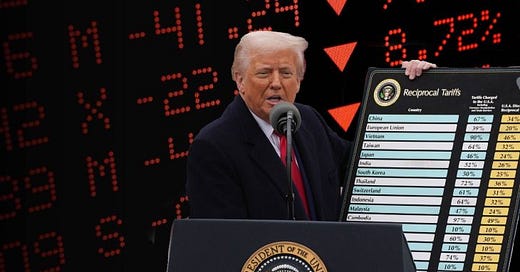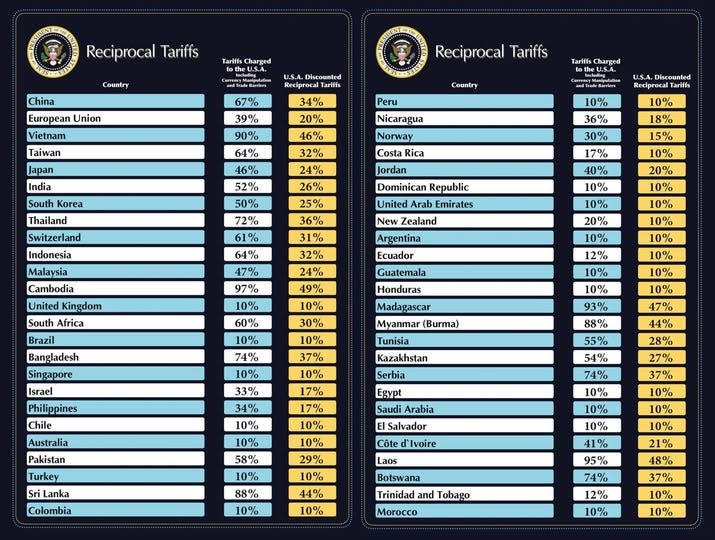💥Tariff is coming (or not) - buying the dip or catching a falling knife? 💥
Evaluating the real tariff impact across the tech sector
The stock market has been quite volatile to say the least. Originally we were planning to publish this post 2 weeks ago when the tariff announcement first hit the stock market, but then with all the pauses and exemption rumors, it has become quite challenging to keep track of what’s going on.
We have decided to publish what we have learned so far (up until the morning of Apr 13, 2025). In this post, our goal is to unpack what has happened on tariffs, as well as the broader impact on the TMT sector.
Recap of what happened
Feb 1st, 2025 - announcement of tariffs on imports from Canada, Mexico, and China
Before Trump announced the reciprocal tariffs on Apr 2nd, Sp500 had come down by 3% year to date as investors were already expecting a negative economic impact from tariffs on Canada, Mexico, and China.
Generally speaking, tariff is terrible for economic growth. Tariff put pressure on global trade as end customers can no longer take advantage of the lower cost of production elsewhere.
Either corporates or consumers need to absorb the extra costs. Corporates either absorb the extra costs themselves and maintain selling prices, or they pass through the extra cost from tariff to end customers in the form of price increase. It hurts demand and slows economic growth. A more likely scenario is somewhere in between.
Apr 2nd, 2025 - announcement of reciprocal tariff
Trump announced reciprocal tariffs on Apr 2nd that were way worse than expected.
The additional duty placed on all imports shall start at 10 percent and the additional duty shall increase for certain trading partners at various rates.
This is way worse than what investors thought, as some were even hoping that Trump might grant some exemptions on Apr 2nd. Instead, he announced additional reciprocal tariffs on many more countries, beyond just China, Mexico and Canada.
The tariffs were egregious with much broader regions and much higher rates. Countries such as Vietnam, Malaysia have historically been viewed as “friend-shoring” and technology companies have been moving manufacturing out of China to these “friend-shoring” locations due to geopolitical tension between the US and China.
The labor costs are much lower than that in the US, and the relationship between these countries and the US have been better than that with China. As a result, companies can effectively lower their manufacturing costs and sell their products to consumers in the US at a health margin.
As a result, the reciprocal tariffs such as 46% on Vietnam and 36% on Thailand were very shocking to investors. Some are even higher than that for China (34%). We thought this is friend-shoring not enemy-shoring?
You never know what is going to come out of the white office these days…
The stock market tumbled, Sp500 was down 11% in the following days. One of the worst trading sessions in recent history.
To protect their capital, hedge funds had to quickly unwind their long positions, which led to even steeper selloffs.
Apr 9th, 2025 - 90-day pause on reciprocal tariff with the exception of China
When you think the market is going to crash like there is no support, Trump announced on Tuesday that there will be a 90-day pause on “reciprocal" tariff with the exception of China.
Sp500 rose 9% on that day. Never a dull day in the market…
However, after the 9% jump, Sp500 gave some gains back in the following days, as the uncertainty on the economic outlook was not entirely eliminated.
Apr 12th, 2025 - announcement of smartphones and computer exemption from reciprocal tariffs
On Apr 12th, 2025 (a Saturday 🙄), Trump announced that smartphone and computers are exempt from reciprocal tariffs. This is mostly targeting goods imported from China, as majority of iPhone today are still manufactured in China.
This is what Trump usually does. He started with something really crazy to force favorable trade deals, and eventually he dialed back from some of his crazy policies.
Negative margin and volume impact from tariff
There are two reasons why the market is down. Tariff is one thing. It’s terrible for corporate margins, but many companies in the Sp500 index with pricing power can pass the incremental cost to consumers, so their margin may not suffer as much.
However, the possibility of a recession caused by tariff is what spooked the market.
Back to what we discussed earlier, depending on the competitive nature of the industry and company’s pricing power, the profit margin itself might not be a huge concern. Many companies can share the extra tariff burden with its end customers.
What is more concerning is the volume impact as customers’ disposable income get squeezed and they shop less, especially the discretionary items (clothes and large ticket item like a new laptop).
That’s exactly why during the recession periods consumer staples companies (Costco, Walmart) tend to outperform the average stock index.
How to evaluate tariff impact on companies?
There are several factors to consider when evaluating the impact to companies:
In the post below, we will share the frameworks to analyze tariff impact for each subsector within TMT (semiconductors, hardware, internet, and software), including supply chain, industry competition and many other factors. A mini-primer on the semiconductor manufacturing process and its associated global supply chain is also included.⬇️
Keep reading with a 7-day free trial
Subscribe to Analyst Journal to keep reading this post and get 7 days of free access to the full post archives.








